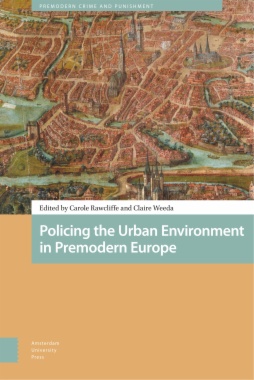Tapping into a combination of court documents, urban statutes, material artefacts, health guides and treatises, Policing the Urban Environment in Premodern Europe offers a unique perspective on how premodern public authorities tried to create a clean, healthy environment. Overturning many preconceptions about medieval dirt and squalor, it presents the most outstanding recent scholarship on how public health norms were enforced in the judicial, religious and socio-cultural sphere before the advent of modern medicine and the nation-state, crossing geographical and linguistic boundaries and engaging with factors such as spiritual purity, civic pride and good neighbourliness.
- Cover
- Contents
- List of Illustrations
- List of Figures and Charts
- Introduction
- Carole Rawcliffe and Claire Weeda
- 1. Cleanliness, Civility, and the City in Medieval Ideals and Scripts
- 2. The View from the Streets
- The Records of Hundred and Leet Courts as a Source for Sanitary Policing in Late Medieval English Towns
- 3. Urban Viarii and the Prosecution of Public Health Offenders in Late Medieval Italy
- 4. Food Offenders
- Public Health and the Marketplace in the Late Medieval Low Countries
- 5. Policing the Environment of Late Medieval Dordrecht
- 6. Muddy Waters in Medieval Montpellier
- Catherine Dubé and Geneviève Dumas
- 7. Regulating Water Sources in the Towns and Cities of Late Medieval Normandy
- 8. Policing the Environment in Premodern Imperial Cities and Towns
- 9. Official Objectives of the Visitatio Leprosorum
- Ambiguity, Ambivalence, and Variance
- Index
- List of Illustrations
- Frontispiece: Map of towns and cities featured in this volume
- 1. The value of mountain air illustrated in a fourteenth-century vernacular regimen sanitatis
- 1.1. The benefits of pure water from a well-illustrated fourteenth-century vernacular regimen sanitatis
- 4.1. View of the Fish Market in Leiden (c. 1600), oil on panel by an anonymous artist. The waste bin, which is first mentioned in fifteenth-century records, is depicted to the right of the centre.
- 5.1. Map of the river delta
- 5.2. Map of Dordrecht in c. 1600
- 6.1. Map of Montpellier in 1665, showing the three hills on which it was built
- 6.2. Location of the most important common wells in medieval Montpellier
- 6.3. Public fountains in Montpellier in the fifteenth century
- 7.1. Engraving of the fountain of Saint-Maclou, Rouen, by Polyclès Langlois, dated 1835
- 7.2. Plan of the course of the Gaalor water source, showing (top centre) the priory church of Saint-Lô with its fountain, in the Livre des fontaines of Jacques Le Lieur, completed in 1525
- 8.1. Ruined leprosy complex with tree stumps, Nördlingen, 1647
- List of Figures and Charts
- Fig. 3.1. General distribution of charges in a selection of registers, 1300-1379
- Fig. 3.2. Distribution of charges in a selection of registers, 1300-1379
- Figure 4.2. Ypres, Rôles de condamnations (1267, 1280, and 1281)
- Figure 5.1: Urban development of Dordrecht
- Figure 5.2: Population density (estimated population and hectares)
- Chart 9.1. Geographical distribution of tallied records
- Chart 9.2. Gender of individuals recorded as having been examined (percentages of the 530 total)
- Chart 9.3. Chronological distribution (530 examinations in total)
- Chart 9.4. Chronological distribution by percentages
- Chart 9.5. Chronological distribution of examinations by region
- Chart 9.6. Verdicts resulting from a visitatio (percentages of the 530 total)
- Chart 9.11. Cologne gendered verdicts
- Chart 9.14. Montferrand gendered verdicts
- Charts 9.7 and 9.8. Verdicts by gender (percentages of the 530 total)
- Charts 9.9 and 9.10. Gendered verdicts by region
- Charts 9.12 and 9.13. Cologne verdicts by gender
- Charts 9.15 and 9.16. Montferrand verdicts by gender
- Charts 9.17 and 9.18. French verdicts by gender without Montferrand

